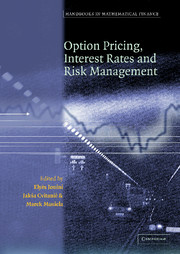Optimization Methods in Finance
Optimization methods play a central role in financial modeling. This textbook is devoted to explaining how state-of-the-art optimization theory, algorithms, and software can be used to efficiently solve problems in computational finance. It discusses some classical mean–variance portfolio optimization models as well as more modern developments such as models for optimal trade execution and dynamic portfolio allocation with transaction costs and taxes. Chapters discussing the theory and efficient solution methods for the main classes of optimization problems alternate with chapters discussing their use in the modeling and solution of central problems in mathematical finance. This book will be interesting and useful for students, academics, and practitioners with a background in mathematics, operations research, or financial engineering. The second edition includes new examples and exercises as well as a more detailed discussion of mean–variance optimization, multi-period models, and additional material to highlight the relevance to finance.
- Numerous examples, exercises, and case studies allow the reader to easily test, experiment, and extend the concepts and models discussed in the main text
- Links together the two important disciplines of optimization and finance, benefiting both
- Technical content gives the reader a solid foundation in the main methods
Reviews & endorsements
Review of first edition: 'This book will be useful as a textbook for students in financial engineering at the MS level. … The book will also be of interest to researchers and graduate students in optimization who are interested in applications of optimization to financial problems.' Brian Borchers, Journal of Online Mathematics and its Applications
Review of first edition: 'This book would certainly appeal to someone with a mathematical background, perhaps in operations research, wishing to update and apply their knowledge to the financial world.' Mathematics TODAY
Review of first edition: 'Until now, there has been no comprehensive optimization book aimed at quantitative analysts in the financial industry. The book by Cornuejols and Tutuncu fills this void … an excellent source for quantitative financial analysts and graduate students to learn about basic optimization theory, computational methods, and available software. At the same time, it can be used by academic researchers and students in optimization as an introduction to various interesting problems in financial applications.' International Review of Economics & Finance
Product details
August 2018Hardback
9781107056749
348 pages
253 × 178 × 21 mm
0.83kg
34 b/w illus. 125 exercises
Available
Table of Contents
- Part I. Introduction:
- 1. Overview of optimization models
- 2. Linear programming: theory and algorithms
- 3. Linear programming models: asset-liability management
- 4. Linear programming models: arbitrage and asset pricing
- Part II. Single-Period Models:
- 5. Quadratic programming: theory and algorithms
- 6. Quadratic programming models: mean-variance optimization
- 7. Sensitivity of mean-variance models to input estimation
- 8. Mixed integer programming: theory and algorithms
- 9. Mixed integer programming models: portfolios with combinatorial constraints
- 10. Stochastic programming: theory and algorithms
- 11. Stochastic programming models: risk measures
- Part III. Multi-Period Models:
- 12. Multi-period models: simple examples
- 13. Dynamic programming: theory and algorithms
- 14. Dynamic programming models: multi-period portfolio optimization
- 15. Dynamic programming models: the binomial pricing model
- 16. Multi-stage stochastic programming
- 17. Stochastic programming models: asset-liability management
- Part IV. Other Optimization Techniques:
- 18. Conic programming: theory and algorithms
- 19. Robust optimization
- 20. Nonlinear programming: theory and algorithms
- Appendix
- References
- Index.










